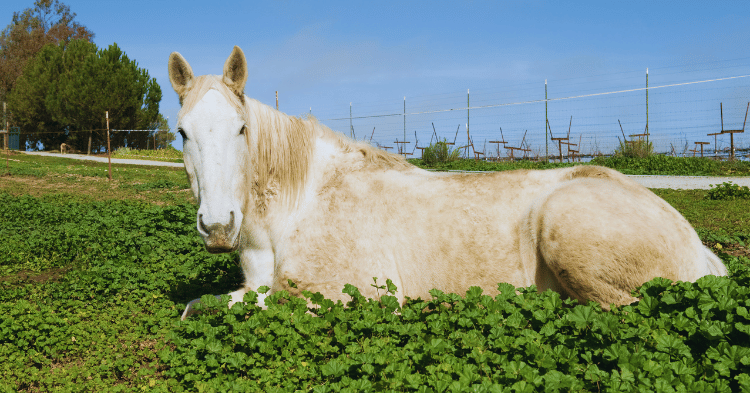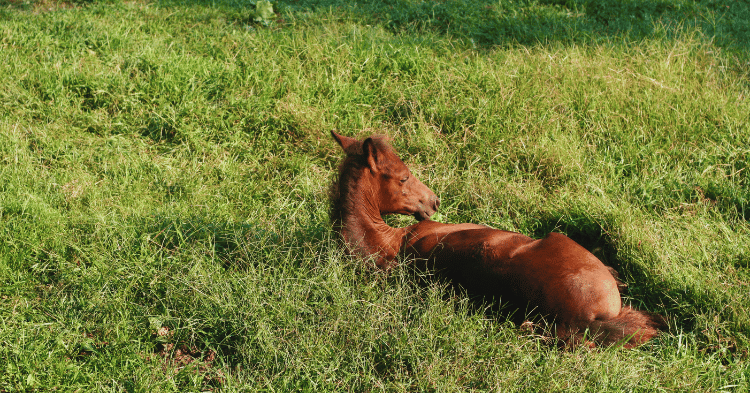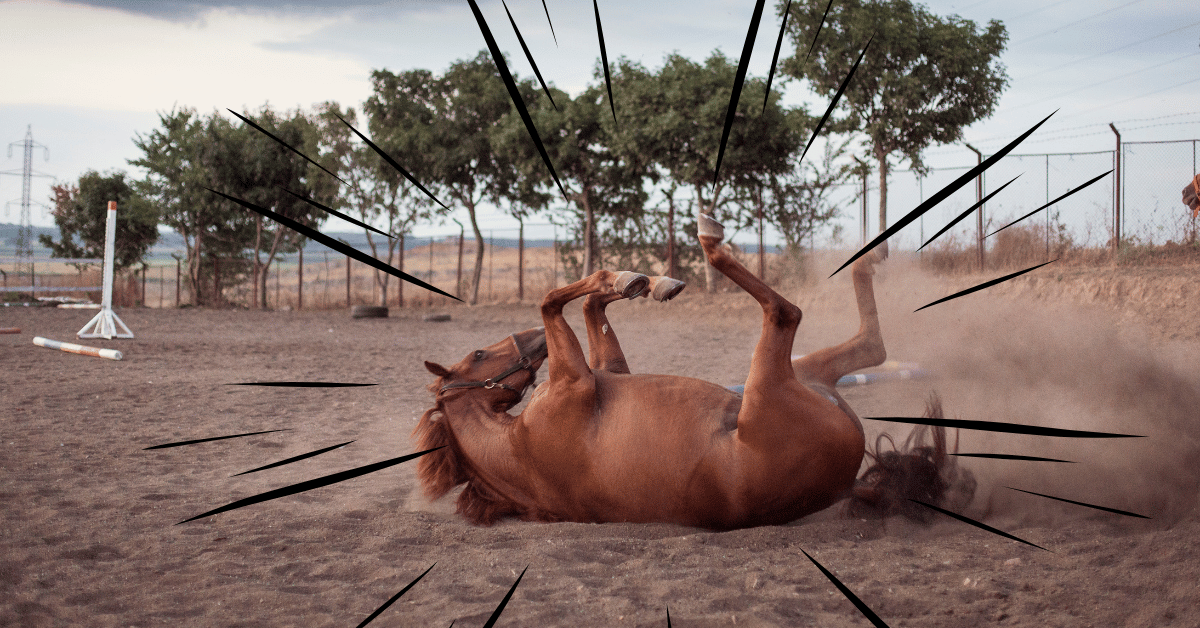When you see a horse lying down, you might ask yourself, do horses lay down as part of their normal behavior, or is something wrong? The answer is simple: yes, horses do lie down, and it’s completely natural. While horses are known for their ability to sleep standing up, thanks to their unique “stay apparatus” that locks their legs in place, lying down is essential for deeper rest.
However, a horse won’t lie down for long periods. As prey animals, their instincts keep them alert to potential dangers, so they often limit their downtime to short, restorative naps. Prolonged lying down, though, can indicate illness or discomfort, making it crucial for owners to understand their horse’s habits. Observing a relaxed horse basking in the sun while lying down is a beautiful reminder of their trust in their environment and their need for occasional deep sleep.
Understanding Horse’s Resting Behavior
Understanding a horse’s resting behavior provides important insight into their overall well-being and health.
Polyphasic Sleep Patterns
Horses are known as polyphasic sleepers, which means they have multiple, discrete sleep episodes within a 24-hour period. Unlike humans, who typically consolidate their sleep into one long period, horses spread their rest throughout the day and night. According to TheHorse.com, horses spend one to three hours lying down each day, split between sternal (upright) and lateral (flat on side) recumbency. Foals, in particular, tend to spend more time recumbent compared to adult horses.
Daily Duration of Lying Down
For optimal health, horses need to lie down for a certain amount of time each day. While horses can sleep standing up due to the stay apparatus in their legs, they require lying down for REM (Rapid Eye Movement) sleep. Horses need about six hours of sleep daily, with most occurring at night. Among this, around 25% is spent in REM sleep, which necessitates lying down.
| Sleep Type | Time Spent (hours/day) |
|---|---|
| Total Sleep | 6 |
| REM Sleep | 1.5 (25% of total) |
| Lying Down | 1-3 |
Daily deep sleep needs can be met with at least 30 minutes of lying down, which can be spread out over the 24-hour period and may not be consecutive (Horse Rookie).
To monitor and ensure that your horse is getting adequate rest, modern technology such as video cameras or wearable monitors can be employed. These tools provide valuable feedback on whether horses lie down at night and for how long they maintain that position.
Connecting with the needs of horses doesn’t just end with acknowledging their resting behaviors; understanding their sleeping patterns also involves knowing their environment, comfort levels, and overall health. For more information, consider our related articles on do horses sleep standing up and do horse sleep lying down.
Importance of Lying Down for Horses

Deep Sleep Needs
Horses spend about six hours sleeping every 24 hours, with the majority of that rest occurring at night. Approximately 25% of their sleep involves rapid eye movement (REM) or dream sleep. Horses need to lie down for REM sleep because all of their muscles, including the stay apparatus in their legs, relax during this stage (The Horse). While horses can sleep standing up, deeper stages of sleep are only achievable when lying down, which is essential for proper brain function.
Potential Risks of Prolonged Standing
Lying down for extended periods can cause serious harm to horses, including cutting off circulation, skin ulcers, muscle damage, and even kidney failure. This can lead to a condition known as “getting cast”. Overweight horses may find it difficult to lie down and rise, which can hinder their ability to achieve REM sleep. Maintaining an appropriate body condition helps horses lie down and rise more easily, ensuring they get adequate rest.
Several factors, including unsuitable environmental conditions, social insecurity, and physical issues like musculoskeletal discomfort, can limit a horse’s ability to lie down. This can result in REM sleep deficiency and excessive drowsiness. Affected horses may enter REM sleep while standing, leading to partial collapse before abruptly waking up.
For additional information on related topics, check out do horses sleep standing up and do horse sleep lying down.
Factors Influencing a Horse’s Sleep

Several elements affect whether horses lay down to sleep and the quality of their rest. Understanding these factors helps horse owners create conditions that promote healthy, restorative sleep for their equines.
Environmental Conditions
Environmental conditions play a crucial role in a horse’s willingness to lie down for sleep. Horses need a comfortable and safe environment to feel secure enough to rest lying down.
Factors:
- Bedding: The type of bedding impacts a horse’s comfort level. Horses tend to lie down more when housed on straw compared to shavings. For more on bedding considerations, refer to our section on bedding considerations.
- Surface: Horses avoid lying down on hard surfaces like concrete but are more likely to rest comfortably on deep and thick bedding.
- Pasture vs. Stall: Pastured horses usually lie down more frequently than those kept in stalls.
| Bedding Type | Likelihood of Lying Down |
|---|---|
| Straw | High |
| Shavings | Medium |
| Concrete | Low |
Pain and Stress Factors
Pain and stress are significant deterrents for horses when it comes to lying down and entering REM sleep.
Factors:
- Pain: Horses experiencing discomfort, particularly from musculoskeletal issues, are less likely to lie down because it might be painful. Overweight horses may also struggle to lie down and stand up due to physical constraints, affecting their sleep quality.
- Stress: Stress from environmental changes, social insecurity, or other factors can hinder a horse’s ability to sleep properly.
- Horses in pain or experiencing high stress levels are prone to entering REM sleep while standing, which can lead to partial collapse and waking up suddenly.
- Uncomfortable Environment: Horses need a large enough stall and appropriate bedding to reduce discomfort and encourage lying down for sleep.
These factors significantly impact whether a horse will lay down and the overall quality of rest they receive. Creating optimal conditions and addressing pain and stress factors is vital for promoting healthy resting behaviors in horses. For more information on promoting healthy resting habits, check out our section on supportive practices for comfort.
Addressing these conditions ensures horses can achieve the quality of rest they need. If you have more questions about whether do horses sleep standing up or other behavior-related queries, explore more articles on horse care.
Promoting Healthy Resting Habits
It’s important for horse owners to facilitate good resting behaviors to ensure their horses get the necessary deep sleep. This section will cover key bedding considerations and supportive practices for comfort.
Bedding Considerations
Bedding choice plays a crucial role in influencing a horse’s willingness to lie down and achieve REM sleep. According to The Horse, horses are more likely to lie down on straw compared to shavings, and they prefer deep and thick bedding over hard surfaces like concrete.
Here is a comparison of time horses spend lying down based on different bedding types:
| Bedding Type | Lying Down Time (Hours) |
|---|---|
| Straw | More |
| Shavings | Less |
| Concrete | Minimal |
Additionally, pastured horses tend to lie down more frequently than stalled horses, suggesting that the environment also affects their resting behaviors.
Horses that lack access to soft, bedded areas rarely lie down and may miss out on adequate REM sleep, which is essential for their overall health. A research group found that providing larger bedded areas where high-ranking and low-ranking horses can lie down comfortably reduces competition and ensures all horses get enough rest.
Supportive Practices for Comfort
Besides choosing the right bedding, other supportive practices can help promote healthy resting habits for horses:
Adequate Space: Ensure that the stall is spacious enough for the horse to lie down and rise without difficulty. Overweight horses might struggle more in cramped spaces, so maintaining an appropriate body condition is essential.
Pain Management: Address any underlying medical conditions such as osteoarthritis. Providing joint supplements containing glucosamine, chondroitin sulfate, hyaluronic acid, and omega-3 fatty acids can support joint health and reduce discomfort, enabling horses to lie down and get back up with ease.
Environmental Conditions: Ensure the stall is free from stressors like excessive noise or bright lights, which can disturb a horse’s rest. Comfort and security in their environment are critical factors influencing a horse’s willingness to lie down.
Regular Veterinary Checks: Regular veterinary assessments can help identify and manage pain or stress factors, further promoting better sleep habits.
By taking these steps, horse owners can significantly enhance their horse’s resting habits, thus ensuring they receive the adequate rest they need. For more information on related topics, feel free to explore our articles on how can horse sleep standing up and do horses sleep on their side.

